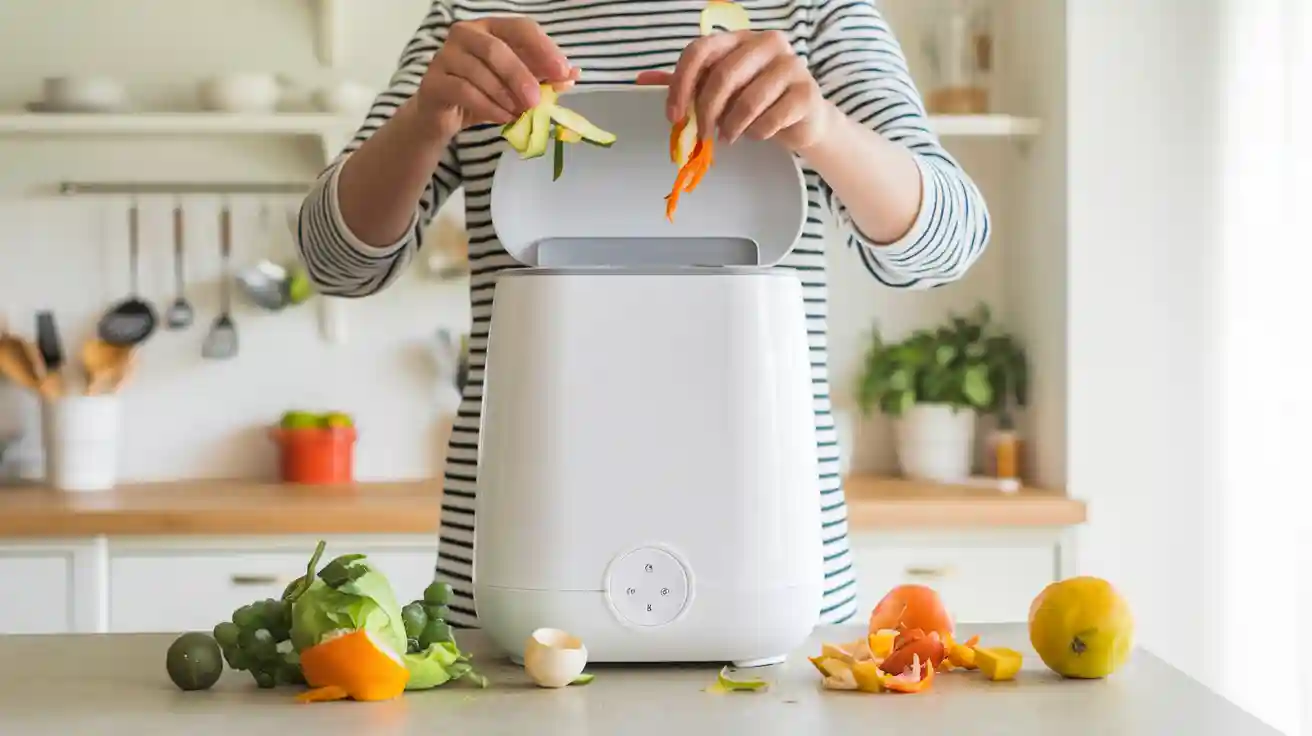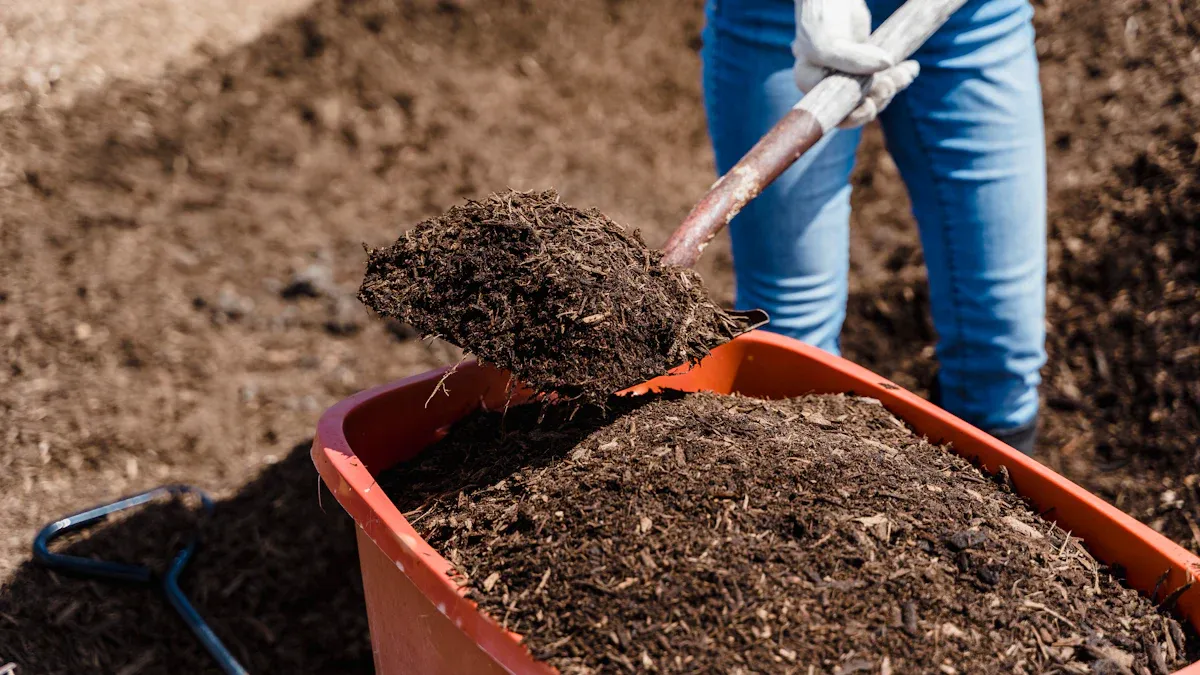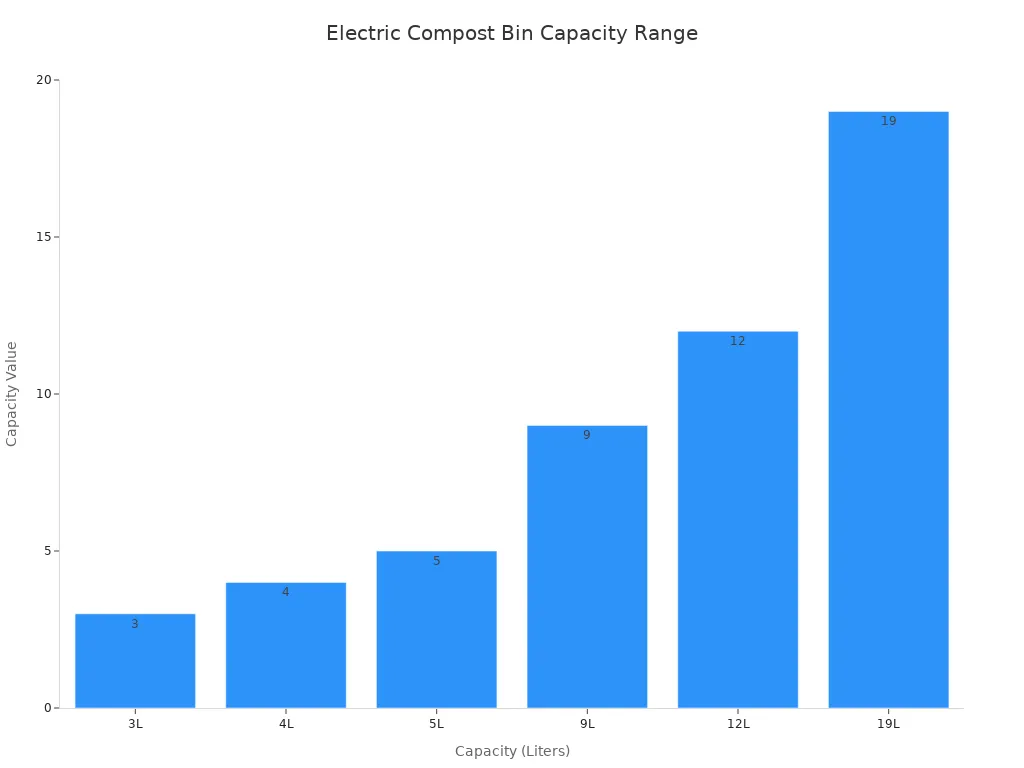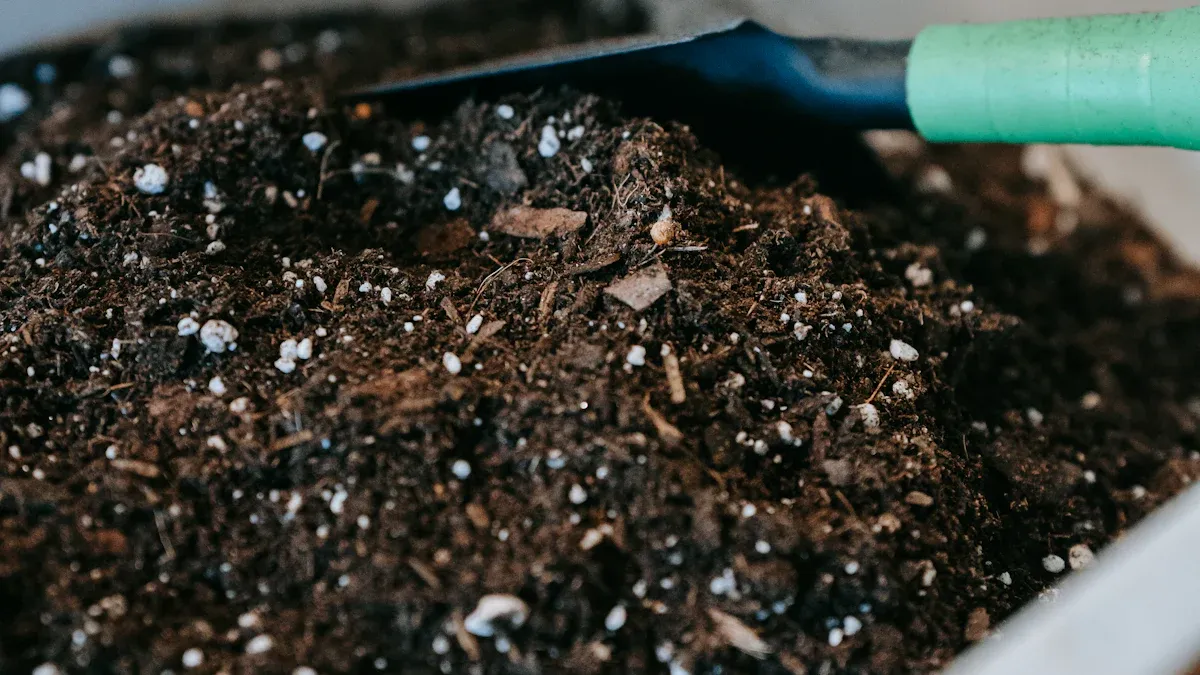
You want an easy way to turn food scraps into rich compost at home. An electric compost bin gives you fast results, odor-free operation, and clean indoor use. The ESIUO WL-S3 stands out for its compact design and simple controls. You save space, avoid pests, and compost year-round.
Why Choose an Electric Compost Bin?
Everyday Convenience
You want composting to fit your busy life. An electric compost bin makes this possible.
- You do not need to turn piles or check moisture every day.
- The machine mixes and aerates your food scraps for you.
- Sensors inside adjust temperature and moisture, so you do not have to guess.
- You can compost indoors, even in an apartment or small kitchen.
- You can use it all year, even when it is cold outside.
Tip: Electric compost bins work well for people with limited time, space, or physical ability.
Fast Composting Results
Traditional composting can take months or even a year. With an electric compost bin, you get results much faster.
Here is a quick comparison:
| Composting Method | Average Time to Produce Finished Compost |
|---|---|
| Lomi Electric Composter | 3 to 20 hours (mode-dependent) |
| Neakasa Electric Composter | Up to 48 hours |
| Traditional Composting | Several months to up to 1 year |
You can turn kitchen scraps into usable compost in just a few days or even hours. This speed helps you reduce waste quickly and see the benefits sooner.
Odor-Free Operation
You may worry about smells from composting indoors. Modern electric compost bins use advanced odor control systems.
- Many models use activated carbon filters to trap odors.
- Some have silicone seals to keep smells inside.
- Air circulation systems help prevent decay-related odors.
- Special microbial packs and temperature controls keep the composting process clean.
You can compost meat and dairy safely without worrying about bad smells in your kitchen.
Electric Compost Bin Key Features

Capacity and Size
When you choose an electric compost bin, you need to think about how much food waste your household produces. The right capacity helps you avoid emptying the bin too often or running out of space. Most models range from compact 3-liter bins to large 19-liter units. Smaller bins work well for individuals or couples, while larger bins suit families or homes with lots of food scraps.
| Capacity (Liters) | Product Example / Description | Suitability / Notes |
|---|---|---|
| 3L | iDOO Electric Compost Bin | Compact countertop model, ideal for small households or low waste producers |
| 4L | 4 Liter Electric Smart Compost Bin | Slightly larger, suitable for managing daily family food waste, multiple cycles per day |
| 5L | FoodCycler Eco 5 | Mid-size capacity, good for moderate food waste volumes |
| 9L | GEME Bio Smart Electric Composter | Larger capacity, processes a tremendous amount of daily food waste, faster breakdown time |
| 12L | Neakasa Kitchen Composter | Large capacity, reduces frequency of emptying, suitable for bigger households or longer use without disposal |
| 19L | GEME Bio Smart Electric Composter | One of the largest indoor composters, suitable for high volume waste producers |

- If you live alone or with one other person, a 3L or 4L bin is usually enough.
- For a family or busy kitchen, a 9L or 12L bin can handle more scraps and needs less frequent emptying.
- Large households or those who cook often may prefer a 19L bin.
Tip: Pick a size that matches your daily food waste to avoid overflow or wasted space.
Composting Speed
You want quick results when you compost indoors. Most electric compost bins finish a cycle in just a few hours. Smaller countertop models often work faster than larger floor models. Here is a comparison of cycle times:
| Model | Cycle Time Range (hours) | Capacity | Notes |
|---|---|---|---|
| Airthereal Revive | 2 to 7 | 10.5 cups (smallest countertop) | Fastest model; completes cycle as fast as 2 hours |
| Luma Kitchen Composter | 3 to 6 | 10.5 cups | Compact, quiet, countertop model |
| Geme Electric Composter | 6 to 8 | 80.3 cups (floor model) | Larger capacity; longer cycle times |
Most leading models process food waste in 2 to 8 hours. Smaller bins finish faster, while larger bins take a bit longer because they handle more material.
Odor Control Technology
Odor control is important for indoor composting. You do not want your kitchen to smell bad. Many electric compost bins use activated carbon filters to trap smells. Some models have silicone seals and air circulation systems to keep odors inside. These features let you compost meat, dairy, and other foods that would smell in a regular bin.
- Activated carbon filters absorb odors.
- Sealed lids and silicone gaskets keep smells from escaping.
- Air pumps and fans help prevent decay and bad smells.
Note: Good odor control means you can place your bin anywhere in your home without worry.
Noise Level
You may wonder if an electric compost bin will be noisy. Most models run quietly, so you can use them in your kitchen without disturbance. For example, the Yeeboover P30 produces only 48 decibels, which is almost silent. The MoreBorn by Neakasa runs at 45 decibels, similar to a refrigerator.
| Electric Compost Bin Model | Noise Level (dB) | Noise Description |
|---|---|---|
| Yeeboover P30 | 48 | Virtually inaudible |
| MoreBorn by Neakasa Kitchen Composter | ≤ 45 | Comparable to refrigerator noise |
You can run your compost bin day or night without worrying about noise.
Energy Efficiency
Electric compost bins use electricity, but they do not use much. Most models consume between 0.6 and 1.5 kilowatt-hours (kWh) per cycle. For example, the Lomi uses about 0.6 kWh in Express Mode and 1.0 kWh in Grow Mode. The FoodCycler uses around 1.5 kWh for a 4-6 hour cycle. This energy use is similar to or less than many common kitchen appliances.
Tip: Running your electric compost bin costs only a few cents per cycle, making it an efficient choice for home composting.
User-Friendly Design
You want a compost bin that is easy to use. Many models have simple controls, clear displays, and automatic features. Some bins have hands-free operation, timer displays, and easy-to-clean parts. Compact and sleek designs fit well in any kitchen. Features like carbon filters, motorized mixing wands, and automatic cycles make composting simple for everyone.
- Sleek appearance fits modern kitchens.
- Simple controls and displays show cycle progress.
- Hands-free options and easy-lift lids add convenience.
- Automatic mixing and heating reduce manual work.
Many users say these features make composting easy, even for children or busy adults.
Maintenance and Cleaning
You do not want to spend a lot of time cleaning your compost bin. Electric compost bins need less maintenance than traditional bins. Most models have sealed lids, charcoal filters, and auto-cleaning cycles. You should empty the scrap container daily and run the machine several times a week. Cleaning is easy, and you do not have to deal with mess or bad smells.
- Low maintenance due to dry, odor-free composting.
- Sealed lids and filters keep pests and smells away.
- Auto-cleaning cycles reduce manual scrubbing.
- Occasional cleaning is needed if jams occur, but the machine will alert you.
Compared to outdoor compost piles, electric bins save you time and effort.
Safety Features
Safety matters when you use any appliance in your home. Electric compost bins include features to protect you and your family. Many models have automatic shut-off, child locks, and overheat protection. Sealed lids prevent accidental opening during operation. These features help you compost safely, even in homes with children or pets.
- Automatic shut-off stops the machine if it overheats.
- Child locks keep curious hands safe.
- Sealed lids prevent spills and accidents.
Always check the safety features before you buy a new compost bin.
ESIUO WL-S3 Electric Compost Bin Review
WL-S3 Overview
You want a composting solution that fits your kitchen and your lifestyle. The ESIUO WL-S3 offers a compact design with smart features. This model helps you turn food scraps into pre-compost quickly and cleanly. You can use it indoors without worrying about mess or odor. The WL-S3 stands out for its quiet operation and easy-to-use controls.
Here is a quick look at the main specifications:
| Specification | Details |
|---|---|
| Capacity | 3 liters |
| Odor Reduction | Up to 80% reduction with activated carbon filter |
| Noise Level | Less than 45 dB |
| Auto Power-Off | Yes, after cooling cycle |
| Auto-Clean Function | Yes, simple process |
| Warranty | 1-year limited |
| Customer Support | USA-based |
| Output | Dehydrated pre-compost for outdoor garden use |
Capacity and Space-Saving Design
You may have limited counter space in your kitchen. The WL-S3 electric compost bin holds up to 3 liters of food scraps. This size works well for individuals or small families. You can place it on your countertop or tuck it into a corner. The compact shape lets you compost daily waste without taking up much room. You do not need to empty it every day, but you also avoid letting scraps pile up.
Tip: A 3-liter bin is ideal if you want to compost small amounts often and keep your kitchen tidy.
Processing Speed and Efficiency
You want fast results when you compost indoors. The WL-S3 processes food scraps into dehydrated pre-compost in just a few hours. The machine uses heat, aeration, and grinding to break down waste quickly. You can run several cycles each week. This speed helps you reduce kitchen waste and produce material for your garden in less time.
Odor Filter and Control System
You do not want bad smells in your home. The WL-S3 uses an activated carbon filter to trap odors. This system reduces smells by up to 80%. The sealed lid and filter work together to keep your kitchen air fresh. You can compost a variety of foods, including items that usually cause odors, without worry.
Note: Activated carbon filters need replacement every few months for best performance.
Noise Performance
You may worry about noise from an electric compost bin. The WL-S3 runs at less than 45 decibels. This level is quieter than most refrigerators. You can run the machine day or night without disturbing your household. The quiet motor lets you compost in open kitchens, apartments, or shared spaces.
Energy Consumption
You want to save energy and money. The WL-S3 uses efficient heating and drying cycles. Each cycle uses a small amount of electricity, similar to other kitchen appliances. You can compost food scraps without seeing a big change in your energy bill.
User Interface and Controls
You want a compost bin that is easy to use. The WL-S3 features simple buttons and a clear display. You can start a cycle with one touch. The auto-clean function makes maintenance easy. The machine alerts you when a cycle finishes or when cleaning is needed. You do not need to read a long manual to get started.
Cleaning and Maintenance
You want to spend less time cleaning. The WL-S3 includes an auto-clean function. You remove the inner pot, add water, and press the Clean button. The machine handles the rest. The design prevents food from sticking and makes emptying simple. You only need to replace the carbon filter and wipe the exterior as needed.
Safety and Reliability
You want a safe appliance in your home. The WL-S3 has an auto power-off feature. The machine shuts down after the cooling cycle to prevent overheating. The sealed lid keeps children and pets safe. You get a 1-year limited warranty and USA-based customer support. You can trust the WL-S3 to work reliably every day.
Pros and Cons
Here is a quick summary to help you decide if the WL-S3 is right for you:
Pros:
- Compact size fits small kitchens
- Quiet operation (less than 45 dB)
- Up to 80% odor reduction
- Simple auto-clean function
- Easy-to-use controls
- Reliable safety features
- 1-year warranty and USA support
Cons:
- 3-liter capacity may be too small for large families
- Carbon filter needs regular replacement
- Only produces pre-compost, not finished soil
If you want a compact, quiet, and easy-to-use electric compost bin, the WL-S3 offers a strong choice for everyday home use.
Comparing the ESIUO WL-S3 Electric Compost Bin

Comparison with Other Electric Compost Bins
When you look at different electric compost bins, you will notice some important differences. Many models offer fast composting, but the speed and ease of use can vary. Some bins take up a lot of space and may not fit well in small kitchens. Others might struggle with odor control or make too much noise during operation.
Here is a quick comparison:
| Feature | ESIUO WL-S3 | Typical Electric Compost Bin |
|---|---|---|
| Composting Time | 24 hours | 24-48 hours |
| Odor Control | Multi-layer (carbon + UV) | Basic carbon filter |
| Noise Level | Low (<45 dB) | Moderate (45-55 dB) |
| Size | Compact (3L) | Varies (3-19L) |
| Meat & Dairy Composting | Yes | Sometimes |
| Maintenance | Minimal | Moderate |
You can see that the WL-S3 stands out for its compact size, advanced odor control, and quiet operation. Many other bins do not handle meat or dairy as safely. Some require more frequent cleaning or filter changes.
Unique Advantages of the WL-S3
You get several unique benefits when you choose the WL-S3 electric compost bin:
- Rapid composting process: turns food waste into compost in just 24 hours.
- Simple controls: easy for all family members, even children, to use.
- Compact design: fits in small kitchens, apartments, or urban homes.
- Advanced odor control: sealed system with multi-layer filtration, including activated carbon and UV sterilization.
- Quiet and energy-efficient: uses less electricity than most kitchen appliances and runs quietly.
- Handles meat and dairy safely, which many bins cannot do.
- Produces dry, nutrient-rich compost ready for your garden or houseplants.
- Minimal maintenance: only occasional filter changes and easy cleaning.
- Cost-effective: helps you save on waste disposal by reducing trash volume.
- Supports sustainable living by cutting landfill waste and lowering your carbon footprint.
Tip: If you want a reliable, easy-to-use electric compost bin that fits your lifestyle, the WL-S3 offers features that many other models do not.
Electric Compost Bin Buying Tips
Choosing the Right Size for Your Home
You want a compost bin that matches your household’s needs. Start by thinking about how much food waste you create each day. If you live alone or with one other person, a smaller bin works well. Families or people who cook often may need a larger model. Space matters, too. Compact bins fit on kitchen counters, while bigger ones need more room. The type of food waste you produce also affects your choice. Some bins handle meat and dairy, while others do not. Quick composting speed lets you use a smaller bin more often. Use the table below to help you decide:
| Factor | Explanation |
|---|---|
| Capacity | Match the bin’s size to your daily or weekly food waste. |
| Space Availability | Check your kitchen or storage space before buying. |
| Type of Food Waste | Choose a bin that handles your usual scraps, including meat or dairy if needed. |
| Speed of Composting | Faster bins let you use smaller sizes more often. |
| Ease of Use | Pick a bin that is easy to maintain and clean. |
| Odor Control | Look for strong odor filters, especially for indoor use. |
| Environmental Impact | Consider energy use and how it fits your green goals. |
| Budget | Make sure the price fits your spending plan. |
Tip: Measure your available space before you buy.
Prioritizing Features for Your Needs
You should focus on features that make composting easy and effective. Look for a bin with a large enough capacity, strong odor control, and quiet operation. Fast processing time helps you manage waste quickly. Some bins let you add food at any time, which adds convenience. Maintenance matters, too. Auto-cleaning cycles and easy filter changes save you time. Here are key features to consider:
- Large capacity reduces emptying.
- Dual odor control keeps your kitchen fresh.
- Quiet operation (≤ 45 dB) avoids noise problems.
- Fast composting cycles save time.
- Handles most kitchen waste, including cooked food.
- Simple maintenance with auto-cleaning and easy filter replacement.
- Energy efficiency keeps costs low.
- High user ratings show reliability.
Note: Choose features that match your lifestyle and kitchen habits.
Budget and Value Considerations
You want the best value for your money. Most electric compost bins cost between $300 and $540 in the first year. Higher prices often mean bigger capacity, better odor control, and faster composting. Some models use subscriptions for filters or microbes, which adds to the cost. Lower-priced bins may have fewer features or smaller sizes. Think about what matters most to you—speed, size, or convenience. A higher upfront cost can save you time and effort in the long run.
Callout: Compare features and ongoing costs before you decide. The right choice gives you both convenience and value.
You want a composting solution that works for your home. The ESIUO WL-S3 offers quiet operation, strong odor control, and easy cleaning. Focus on capacity, odor filters, and safety when you choose a model. Pick a compost bin that matches your kitchen and your daily routine.
FAQ
How often should you clean your electric compost bin?
You should clean your bin after every few cycles. Use the auto-clean function if available. Wipe the exterior and replace the carbon filter as needed.
Can you compost meat and dairy in an electric compost bin?
Most electric compost bins, including the WL-S3, let you compost small amounts of meat and dairy. Always check your model’s guidelines for best results.
What can you do with the finished compost?
You can mix the finished compost into garden soil, use it for houseplants, or spread it around outdoor plants to enrich the soil and support healthy growth.


